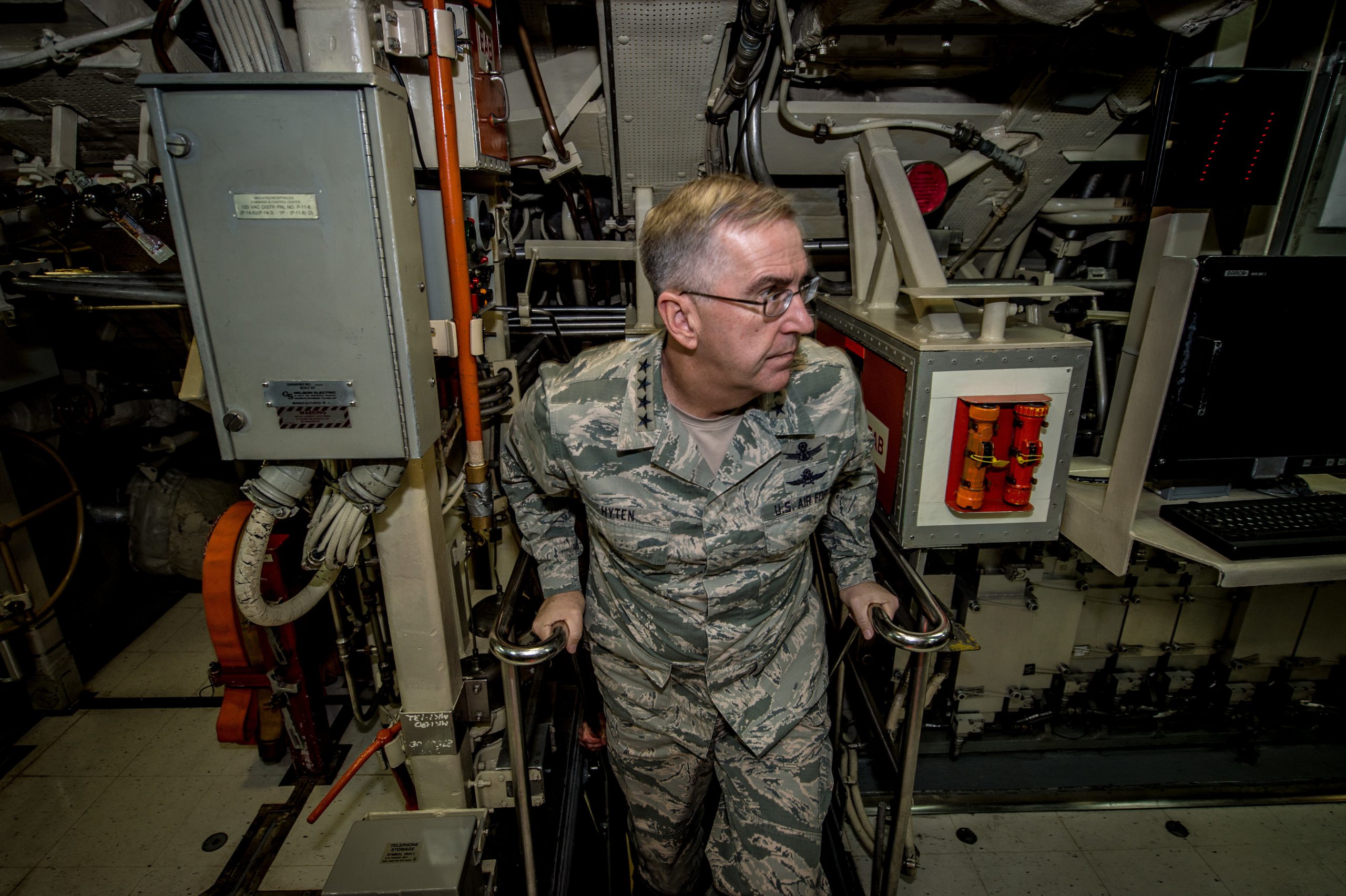From a warfighter’s stance, the 2018 Nuclear Posture Review changes the strategic environment as a threat-based approach, the commander of U.S. Strategic Command says..
Washington D.C. — (DoD News) — February 16, 2018 — From a warfighter’s stance, the 2018 Nuclear Posture Review changes the strategic environment as a threat-based approach, the commander of U.S. Strategic Command said here today.
Air Force Gen. John E. Hyten delivered the keynote address at a seminar on the posture review at National Defense University’s Center for the Study of Weapons of Mass Destruction.

Air Force Gen. John E. Hyten, commander of U.S. Strategic Command, tours the Ohio-class ballistic missile submarine USS Pennsylvania as part of a visit to Naval Base Kitsap-Bangor, Wash., Jan. 18, 2018. Hyten delivered the keynote address at a National Defense University seminar on the 2018 Nuclear Posture Review, Feb. 16, 2018. Navy photo by Petty Officer 2nd Class Nancy C. di Benedetto.
The 2018 review is the Defense Department’s fourth review of U.S. nuclear policy, posture and programs since the end of the Cold War. The strategic environment has significantly evolved in the past two decades, Hyten said.
“Our adversaries are building and operating these strategic weapons, not as a science experiment, but as a direct threat to the United States of America,” he said.
The strategic environment is dynamic and changes constantly, the general said, noting that the U.S. approach to deterrence must be equally dynamic to address such threats.
Stratcom Commander Hosts Nuclear Posture Seminar
“This tailored deterrence approach requires us to have flexible capabilities that include a broad mix of yields and modernized platforms to credibly deter the spectrum of adversaries and threats we face today and in the future,” Hyten said.
Posture Strong Today, Future Uncertain
As the Defense Department evaluated its nuclear posture in light of the threats the United States faces, the department found the posture is strong today, he said. “We have everything we need to address the threats of today,” he told the seminar audience.
“But it is potentially lacking in the future,” he added. “My worry is that if we do not act now within the next decade, unlike me, one of my successors might not have the appropriate flexible and tailored capabilities to give the president of the United States options to adequately deal with the uncertain and evolving security environment.”
Preventing Conflict by Preparing for Conflict
The best way to prevent conflict is to be prepared for it, Hyten said — to be prepared to impose unacceptable cost and deny any benefit that any adversary may perceive. That, he said, is deterrence.
The Nuclear Posture Review defines and expands on what hedging against an uncertain future means for nuclear weapons, Hyten noted.
“As witnessed over the past decade, the security environment can change quickly,” he explained. “Technology is constantly evolving. Adversaries are seeking to use these technologies to advance their own capabilities and put ours at risk. Hedging against an uncertain future means ensuring we’re always ready, always confident, no matter what the future holds.”
That requires an agile, adaptable deployed force and a responsive infrastructure, which requires trained, educated men and women dedicated to the mission and postured for success, the Stratcom commander said. It also means having the flexibility to adjust the force with new capabilities and acquire systems quickly, he added.
“Our deterrence force is strong, powerful and ready, but the pace of change in the strategic environment is rapid and demands that we adapt how we operate in order to stay ahead of evolving threats,” Hyten said. “And, if we’re not careful, I’m afraid, 10 or 20 years from now, our deterrent capabilities will be at risk. The United States cannot let that happen, he said.
Lost Ability for Fast Pace
“What really worries me is this: I’m afraid our country has lost the ability to go fast,” the general said. “And, if we’re to be successful in modernizing our capabilities to respond to this threat, it’s going to require some big changes in the way we operate.”
The DoD budget, requirements, acquisition and testing processes are all too slow, he said. The solution, he said, is to get away from a culture that is risk-averse and empower people to move fast once again.
“First, we need a budget,” he said. “It’s a critical enabler for everything else. I was encouraged last week, when Congress agreed to a defense budget framework that provides stable funding for the next two years. That would be huge.
“We also need to fix our requirements process,” he continued. “Why does it take years to build a set of requirements?”
No Change in Adversary Behaviors, Stratcom Commander Says Washington
Hyten said DoD program managers in the acquisition process have to get approval for everything. “They’re not authorized to make … any decisions,” he added. “You can’t execute a program that way. So we have to give our program managers the authority and responsibility to move fast, and then hold them accountable.”
DoD also needs a test process that is efficient and also moves fast, he said, and operators need to understand how to take operational risk and be given the opportunity to do so when it comes.
“We need to empower commanders to take logical risk about how to employ weapon systems [and] how to accept weapon systems,” Hyten said. “Our modernization efforts will not be successful if we only address one of the issues. We won’t solve the problem. We need to fix all of these things — budget requirement, acquisition, test, risk — if we’re to make a difference.
“Signs of improvement are beginning to show,” he noted, but “we must move fast to respond to threats.”
(Follow Terri Moon Cronk on Twitter: @MoonCronkDoD)
Related Links
Hyten Nuclear Posture Redview Nuclear Posture Special STRATCOM Strategic Command Strategic Deterrence










